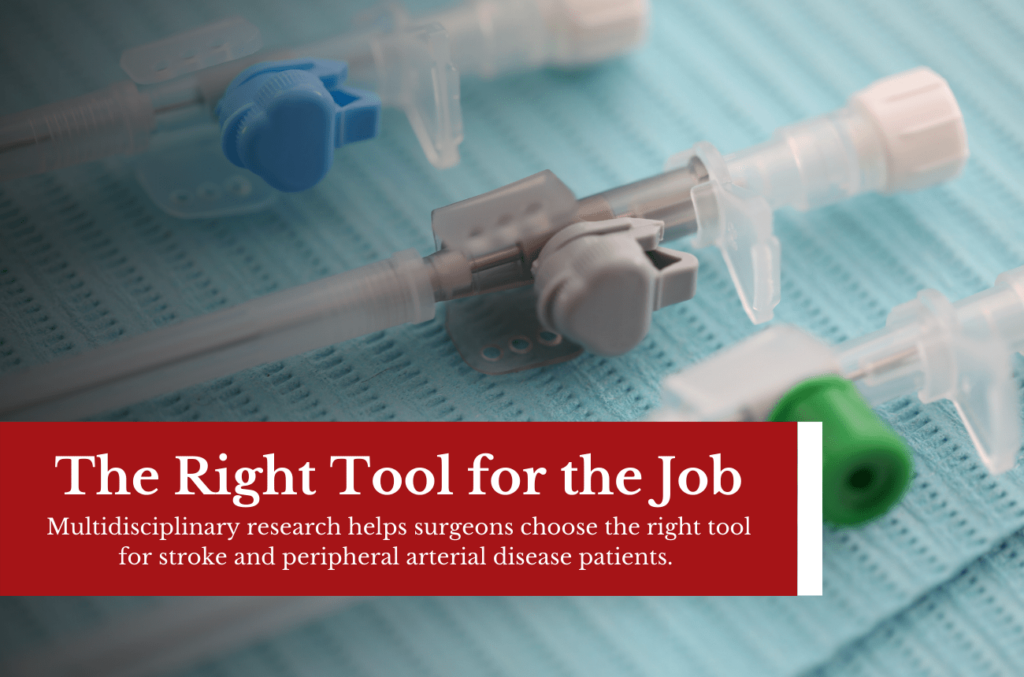Millions of lives are saved worldwide each year by vascular surgeries that involve advancing a tool known as a catheter to the site of a blood clot or aneurysm. These catheters are critical to treating stroke and peripheral arterial disease, which impact over 20 million Americans on a yearly basis, and are especially critical to the St. Louis region as they often affect people with cardiovascular risk factors as well as higher proportions of underserved minority populations.
The central challenge with these surgeries is picking the right tool. This has been done only empirically in the past, and educated guesses that go wrong are an impediment to patient care.
A multidisciplinary team of Washington University researchers from neurosurgery, vascular surgery, and mechanical engineering gathered in the Center of Innovation and Neuroscience Technology (CINT) to develop a novel solution for this vexing problem.
“Discovering that a catheter is not going to work for a patient’s anatomy costs time and money in vascular surgery,” says senior author Mohamed Zayed, MD, PhD, Associate Professor of Surgery. “We have long needed a framework for quantitatively choosing tools.”
The multi-disciplinary group of investigators at Washington University School of Medicine in St. Louis and McKelvey School of Engineering has now developed a framework for characterizing the flexural rigidity of endovascular catheters used for peripheral neurovascular and lower extremity procedures, and developed the first chart for selection of tools.
The team’s research findings are published in the Journal of the Mechanical Behavior of Biomedical Materials.
“The team of McKelvey undergraduates who developed this framework was remarkably creative,” said co-senior author Guy Genin, Faught Professor of Mechanical Engineering and Chief Engineer at CINT. “By combining advanced image analysis with mechanics analysis and frameworks used for materials selection, they developed a foundation for turning a surgical art into a science.”
The McKelvey students are seniors Chase Hartquist, Halle Lowe, and Vinay Chandrasekaran, all of whom are graduating this spring. Hartquist and Lowe are graduating with MS degrees as well, and all are inventors on an associated patent application filed by the Office of Technology Management.
Co-author Joshua Osbun, MD, Associate Professor of the Neurosurgery and Chief of Vascular Innovation in the Division of Neurotechnology, noted that “Challenging vascular anatomy can impede efficient navigation of catheters within a vessel for effective non-invasive treatment of stroke and peripheral arterial disease. By evaluating catheter technology and performing flexural rigidity assessments, this work can help us reduce the impact of catheter buckling, kinking, and herniation in a range of surgeries.”
This collaborative research led to the development of a new standardized unit assessment for flexural rigidity, published in the Journal of the Mechanical Behavior of Biomedical Materials. The study findings provide a novel tool for the development and testing of next generation neurovascular and peripheral vascular catheters specifically tailored to enhance navigation across tortuous or difficult vascular anatomy.
CINT Director Eric C. Leuthardt, MD, Professor of Neurological Surgery and Chief of the Division of Neurotechnology, who was not involved in the study, noted, “This is a remarkable example of cross-school collaboration leading to impact both in the field of surgery and to the St. Louis region. This need has been around for years, and could not have been addressed without a talented team that bridges the expertise at Washington University.”
